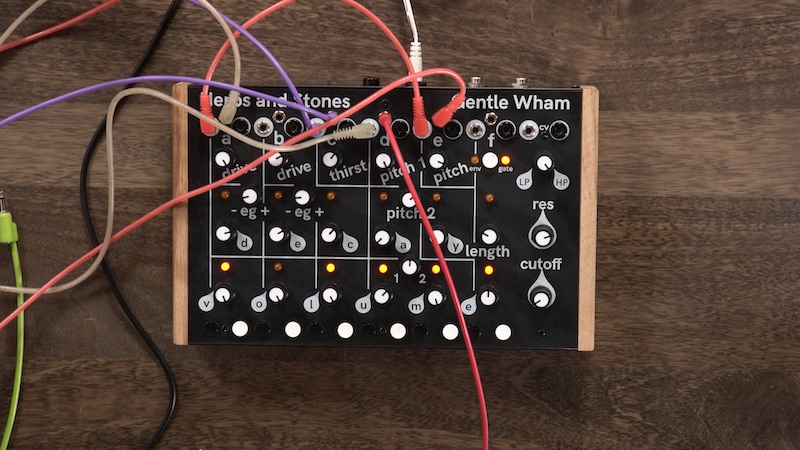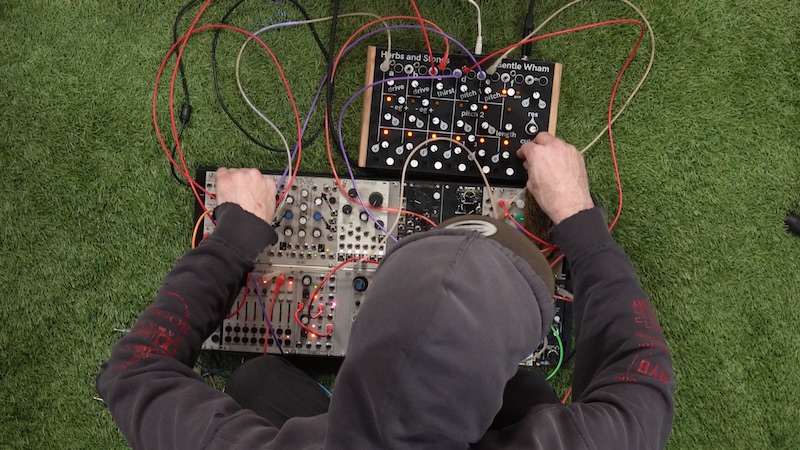The Herbs and Stones Gentle Wham is a standalone desktop analog drum synthesizer designed to fit into a huge range of workflows. You won't find MIDI control onboard—but you will find a wide host of connections for gate sequencers and modular systems, making Gentle Wham an ideal side piece to complement your modular synthesizer...be it Euroarck, Serge, Buchla, Ciat-Lonbarde, or most any other modular system out there.
Herbs and Stones's first release Liquid Foam provided a peculiar and fun take on the classic bassline/groovebox concept—like a semi-modular Roland TB-303 with a sequencing scheme based on generative, chaotic processes. Gentle Wham most certainly brings with it a similar perspective, turning the typical concept of a drum machine inside-out to create fresh, peculiar, and mesmerizing sounds. Let's take a look at how it works.
A Drum Synth Full of Quirky Delights
Gentle Wham is an analog drum synth with six independent, unique voices. Voices can be triggered manually using per-channel buttons (great for finger drumming), or from the per-channel banana and 3.5mm inputs at the top of each channel. Of course, the inclusion of both banana and 3.5mm trigger inputs makes it quite easy to use Gentle Wham in a wide variety of setups. Each channel also features an individual volume control, direct audio outputs, mute switch, and variable parameters related to that channel's specific intended function...but more on that as we go. Gentle Wham also features an internal mixer with a hardwired DJ-style resonant lowpass/highpass filter, great for shaping the entirety of your mix and creating a sense of motion during performance. The filter also features a CV input for the cutoff frequency, which can be an absolute blast to sequence, randomize, and otherwise modulate the crap out of during performance.
Perhaps one of the most important things to note about Gentle Wham—its individual channels aren't strictly dedicated to a single type of sound each. While each channel is different from one another, they don't approach drum synthesis entirely according to conventional rules. So, while each channel certainly has its own distinct character, you'll quickly discover when using it that each individual channel can be wrenched into producing a pretty huge range of sounds from aggressive industrial tones to outright quirky and bizarre zaps and bleeps. Let's take a look at each channel to discuss what it can do.
Voices A and B are similar in function, producing "classic" drum synthesis well-suited to kicks, toms, and all manner of electronic zaps. Each of these channels features an oscillator and a decay-only envelope generator (which is coupled to the sound's loudness and pitch). The envelope features variable depth and decay time, allowing everything from gentle thuds to full-spectrum face-melting pitch sweeps. These two channels also feature dedicated Drive controls, with a more triangle-like gentle wave shape at low drive levels to more aggressive, distorted, square-like wave shapes at higher Drive amounts. The only difference between these two channels is their pitch range—voice A is lower and B is higher, making A perhaps better-suited to kick sounds while B is perhaps better-suited to toms, effects, bass sounds, and more.
Voice C excels and more chaotic sounds—generated by abusing obsolete ICs until they produce unruly, gritty noise textures. The Thirst parameter is a voltage/current starvation function, providing a surprisingly wide range of sounds well-suited to weird snares, hats, or other less pitch-centric percussive tones. Like A and B, this voice features a decay-only envelope with variable decay length.

Voice D is comprised of two inter-linked voices (D1 and D2) with a crossfader, allowing you to create a continuous blend between its two sound sources. The first sound source is comprised of several fixed-frequency square waves oscillators and four cascaded ring modulators, with a single variable-frequency square wave oscillator at the final ring modulation stage. This technique is similar to how the "cowbell" sound in vintage drum machines works—but it is much swarmier, metallic, and clangorous than its forebears. The second sound source in voice D is a filtered triangle with manual pitch control. The post-crossfade audio passes through a particularly crude VCA controlled by a decay-only envelope (again, with variable decay length). The end result is a voice with the ability to create anything from pitched snare-like sounds, toms, basses, or outrageous clangorous noise textures—you decide. Voice E is similar to voice D's swarmy cowbell ring mod monstrosity, featuring manual control of pitch and envelope decay length.
Voice F is, in my opinion, one of the most interesting, in that it actually does not generate sound by itself. Voice F is a way of gating incoming audio (with a 1/4" input on the rear panel). It has two modes (Env and Gate) and a single parameter control: length. In envelope mode, Length controls the decay length of yet another decay-only envelope; in gate mode, it controls the voice's decay length, allowing for much choppier sounds with no continuous decay. That's...pretty sick. Just plug in your phone, another synth, whatever—Gentle Wham provides a rad way of chopping up any incoming audio.

So, who is Gentle Wham for? It doesn't have MIDI, it doesn't have any built-in sequencing functionality, and it certainly has a peculiar set of features. All in all, we definitely see this as being a welcome addition to modular-centric setups; pair it with a Pam's New Workout, Varigate 8+, or a Zularic Repetitor and you're sure to get all manner of exciting rhythmic oddities. Moreover, the 3.5mm Eurorack-level outputs make it a breeze to process each channel separately in a modular system...so if you want to further customize the sound of the (quite) raw drum voices, there are nearly limitless possibilities at your fingertips. Of course, a modular system isn't a requisite piece of the puzzle: given the sheer number of multi-channel gate sequencers out there (a la Arturia Keystep Pro, Beatstep Pro, Korg SQ-64, etc.), Gentle Wham could just as easily fit into any number of additional workflows. Heck, pair it with a Liquid Foam and you've got a weird, generative, surreal alternative to a TB-303 and TR-606/808.
My biggest takeaway? Gentle Wham takes some of the ideas from classic drum machines and really turns them inside out, using everything from conventional "drum synthesis" to experimental noise electronics techniques to form a tremendously flexible collection of sound sources. Each voice can pull of several different types of sounds easily—and happily, despite Gentle Wham's sonic flexibility, it maintains a sense of immediacy that keeps it fun and intuitive for on-the-fly experimentation. Just choose the way that you want to control it and there's no doubt that it'll turn into something inspiring, energizing, odd, and outright fun.











